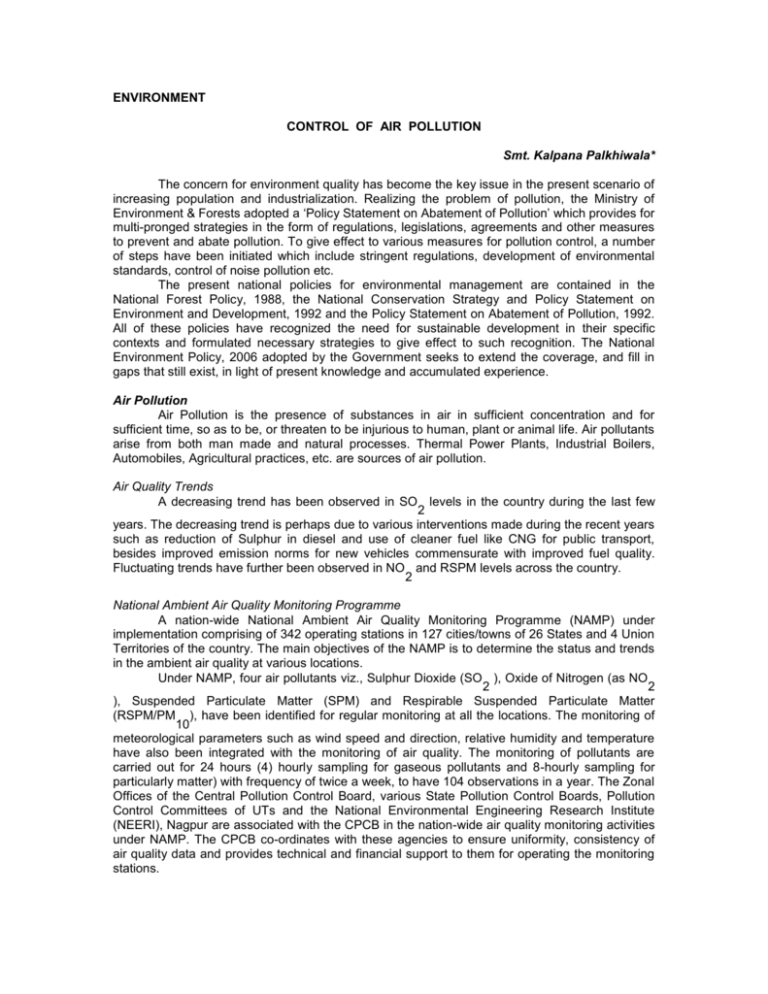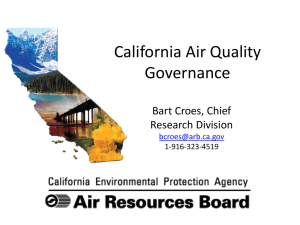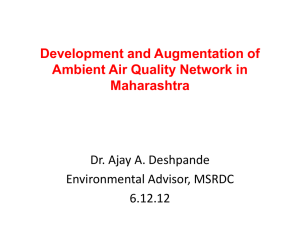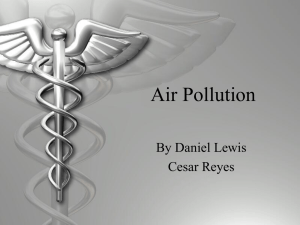ENVIRONMENT
advertisement

ENVIRONMENT CONTROL OF AIR POLLUTION Smt. Kalpana Palkhiwala* The concern for environment quality has become the key issue in the present scenario of increasing population and industrialization. Realizing the problem of pollution, the Ministry of Environment & Forests adopted a ‘Policy Statement on Abatement of Pollution’ which provides for multi-pronged strategies in the form of regulations, legislations, agreements and other measures to prevent and abate pollution. To give effect to various measures for pollution control, a number of steps have been initiated which include stringent regulations, development of environmental standards, control of noise pollution etc. The present national policies for environmental management are contained in the National Forest Policy, 1988, the National Conservation Strategy and Policy Statement on Environment and Development, 1992 and the Policy Statement on Abatement of Pollution, 1992. All of these policies have recognized the need for sustainable development in their specific contexts and formulated necessary strategies to give effect to such recognition. The National Environment Policy, 2006 adopted by the Government seeks to extend the coverage, and fill in gaps that still exist, in light of present knowledge and accumulated experience. Air Pollution Air Pollution is the presence of substances in air in sufficient concentration and for sufficient time, so as to be, or threaten to be injurious to human, plant or animal life. Air pollutants arise from both man made and natural processes. Thermal Power Plants, Industrial Boilers, Automobiles, Agricultural practices, etc. are sources of air pollution. Air Quality Trends A decreasing trend has been observed in SO levels in the country during the last few 2 years. The decreasing trend is perhaps due to various interventions made during the recent years such as reduction of Sulphur in diesel and use of cleaner fuel like CNG for public transport, besides improved emission norms for new vehicles commensurate with improved fuel quality. Fluctuating trends have further been observed in NO and RSPM levels across the country. 2 National Ambient Air Quality Monitoring Programme A nation-wide National Ambient Air Quality Monitoring Programme (NAMP) under implementation comprising of 342 operating stations in 127 cities/towns of 26 States and 4 Union Territories of the country. The main objectives of the NAMP is to determine the status and trends in the ambient air quality at various locations. Under NAMP, four air pollutants viz., Sulphur Dioxide (SO ), Oxide of Nitrogen (as NO 2 2 ), Suspended Particulate Matter (SPM) and Respirable Suspended Particulate Matter (RSPM/PM ), have been identified for regular monitoring at all the locations. The monitoring of 10 meteorological parameters such as wind speed and direction, relative humidity and temperature have also been integrated with the monitoring of air quality. The monitoring of pollutants are carried out for 24 hours (4) hourly sampling for gaseous pollutants and 8-hourly sampling for particularly matter) with frequency of twice a week, to have 104 observations in a year. The Zonal Offices of the Central Pollution Control Board, various State Pollution Control Boards, Pollution Control Committees of UTs and the National Environmental Engineering Research Institute (NEERI), Nagpur are associated with the CPCB in the nation-wide air quality monitoring activities under NAMP. The CPCB co-ordinates with these agencies to ensure uniformity, consistency of air quality data and provides technical and financial support to them for operating the monitoring stations. Air Pollution Control For assessment of the ambient air quality, stations under NAMP have been set-up with data received from the various State Pollution Control Boards (SPCBs) and Pollution Control Committees (PCCs) loaded on the website of the Central Pollution Control Board (CPCB) through the Environmental Data Bank. For control of air pollution, National Ambient Air Quality Standards have been evolved and notified along with the emission standards for highly air polluting industries like Thermal Power Plants, Cement Plants, Iron & Steel Industry, Aluminum Industries, Petroleum Oil Refinery, etc. Vehicular Exhaust Standards for in-use and new vehicles have also been evolved for the purpose. In this regard, standards for new vehicles (Bharat Stage I,II,III & IV Standard) are under implementation at manufacturing stage, fuel quality (Petrol, Diesel, Furnace Oil) standards have also been evolved and notified. Standards to control air pollution from the 17 categories of higly air polluting industries are also under implementation through SPCBs and PCCs. Besides, Source Apportionment Studies (SAS) for Respirable Suspended Particulate Matter (RSPM) have been initiated in six cities namely: Delhi, Mumbai, Chennai, Kanpur, Banglore and Pune across the country. Emphasis has also been laid on the adoption of pollution prevention technologies, guidelines and standards for small scale air polluting industries (like brick kilns, stone crushers, sponge iron plants, etc.). Proposed Targets for Air Pollution Control The number of Air Quality Monitoring Stations under NAMP is proposed to be increased from 342 to 700 during the 11th Five Year Plan with the quality of the data being steadily improved upon by proper calibration of samples, Quality Assurance and Quality Control (QA/QC) exercise, training of personnel, etc. Under the programme, the Ambient Air Quality Monitoring Network is proposed to cover all cities and towns having population more than one lakh, besides critically polluted areas. A total of 33 Continuous Ambient Air Quality Monitoring Stations (CAAQMS) have been installed in Delhi (5), Bangalore (5), Chennai (5), Sholapur (1), Hyderabad (1), Kolkata (2), Mumbai (2), Chanderpur (1), Durgapur (1), Haldia (1), Howrah (1), Ahmedabad (1), Pune (1), Ghaziabad (1), Lucknow (1), Cuddalore (1), Ranipet (1), Tuticorin (1), Vadodara (1). More CAAQMA are proposed to be set-up with real time data posted on website. Steps are proposed to be taken during the 11th Plan to set-up CAAQMS in 59 Metro cities & State Capital cities and in critically polluted areas identified by CPCB. The effective enforcement emission standards in Thermal Power Plants, Sponge Iron Plants, Stone Crushers, Brick Kilns, Coke Oven Plants, Ferro-Alloy Plants, etc. which cause air pollution is also proposed to be undertaken. Specific attention in this context is also proposed to be given on enforcement of standards in small scale air polluting industries (stone crushers, brick kilns, re-rolling mills, etc.). Efficacy of the implementation of the Action Plans in the identified critically polluted areas is further proposed to be evaluated, especially for Control of Hazardous Air Pollutants (HAPs). Action Plans for Control of Air Pollution in 16 Cities Sixteen cities have been identified for preparation of action plans for improvement of the ambient air quality. Out of these, Action Plans for seven cities, namely, Ahemedabad, Kanpur, Sholapur, Lucknow, Banglore, Chennai and Hyderabad are being reviewed by the Environment Pollution (Prevention & control) Authority (EPCA). Action Plans for Kolkata and Mumbai are being reviewed by the respective High Courts/ State Pollution Control Boards. The Action Plans for the remaining seven cities, namely, Agra, Jharia, Varanasi, Faridabad, Patna, Jodhpur and Pune are being reviewed by the Ministry of Environment & Forests. The CPCB has published Guidelines for Ambient Air Quality Monitoring. The Guidelines detail measurement methods of air pollutants, guidelines for location monitoring stations and quality assurance/quality control procedures. The Guidelines have been provided to all the monitoring agencies to have uniformity in the monitoring protocol. Source Apportionment Study The objectives of the frame work for Source Apportionment Study include preparation of emission inventory, emission profile, monitoring of ambient air quality, assessment of data and its authentication and source apportionment of fine dust/RSPM using factor analysis and receptor modeling. Application of Chemical mass balance, Receptor model and ISC dispersion model have also been included in the study. The Study will result in the formulation of appropriate air quality management plan for respective cities and would provide a basis for guidance in the formulation of National Policy in Air Quality Management. A separate study is being carried out for characterization of the particulate matter organic carbon. In addition, a detailed study on Source Apportionment (SA) of fine particulate matter in the ambient air in six cities to identify percentage contribution of various sources to ambient particulate matter has been undertaken. To evaluate contribution from various sources to air quality, SA studies were initiated by Oil Companies in August, 2003 by singing an MoU between Indian Oil Corporation (IOC) and the National Environment Engineering Research Institute (NEERI), for study in Delhi. The scope was subsequently extended to cover six cities with various institutions with an estimated cost of about Rs. 20 crores. The Study is being coordinated by the Central Pollution Control Board (CPCB). For appraisal and guidance during the Study, a National Level Steering committee under the Chairmanship of Secretary (E&F) has been constituted to guide the study. In order to provide technical inputs, a technical Committee has also been constituted under the chairmanship of the Chairman, CPCB with members drawn from various technical institutions and organizations. The Technical Committee has approved the Terms of Reference for different studies, approach, methodology, work plan and deliverables. The CPCB has signed Memoranda of Collaboration (MoC) for Source Appointment Studies for the cities of Mumbai, Chennai and Kanpur with NEERI, IIT-Mumbai and IIT-Kanpur respectively as well as for source profiling of sources other than vehicles with IIT Mumbai. The Automotive Research Association of India (ARAI), Pune has conducted studies on emission factors for vehicles required as inputs in the studies. The result of the Study so obtained is proposed to be evaluated by the Technical Committee and its International peer Review is proposed. These steps are proposed since such source apportionment studies have been carried out for the first time in India and the outcome of this Study would form the basis for future policy decisions. Auto-Fuel Policy The Ministry of Petroleum and Natural Gas has enunciated an Auto Fuel Policy which aims to comprehensively and holistically address the issues of vehicular emissions, vehicular technologies and auto fuel quality in a cost effective manner while ensuring the security of fuel supply. The Policy objectives include ensuring sustainable, safe, affordable and uninterrupted supply of auto fuels, optimum utilization of infrastructure for import of crude and crude products, processing and production, and the storage and transportation; assessing the future trends in emission and air quality requirements from the view point of public health; adopting such vehicular emission standards that will be able to make a decisive impact on air quality. The Policy provides for a road map for reduction in vehicular emission norms for new vehicles as well as reduction of pollution from in-use vehicles. It also sets standards for quality of fuel and other kits. The road map for new vehicles as provided, under the Auto Fuel Policy is as follows: Coverage Passenger Cars, Light commercial vehicals and heavy duty diesel vehicles Entire country Bharat Stage II – 1.4.2005 Euro III equivalent – 1.4.2010 11 major cities Bharat Stage II – 1.4.2003 (Delhi/NCR, Euro III equivalent – Mumbai, Kolkata, 1.4.2005 Chennai, Banglore, Euro IV equivalent – Hyderabad, Ahmedabad, 1.4.2010 Pune, Surat, Kanpur and Agra.) *Deputy Director (M & C), PIB, New Delhi RTS/VN SS-187/SF-187/05.11.2008 2/3 wheelers Bharat Stage II – 1.4.2005 Euro III equivalent – 1.4.2010








